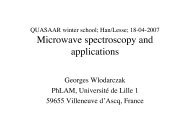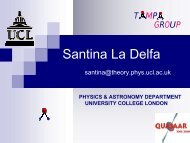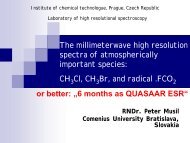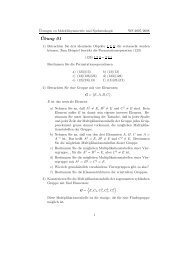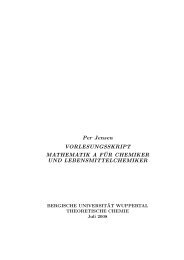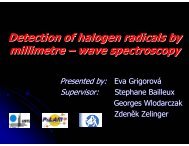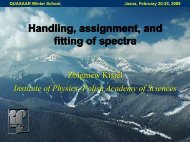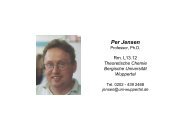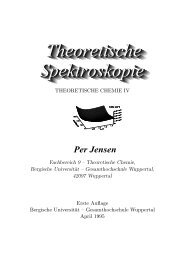170 Poster session, J7Quantum-classical Rydberg electron dynamics in a polar moleculeP. John Shepherd 1 , Vladislav E. Chernov 2,3 , Dmitry L. Dorofeev 3 , M.Yu. Knyazev 31 School of <strong>Ph</strong>ysics, University of Exeter, Stocker Road, Exeter, UK, EX4 4QL,p.j.shepherd@exeter.ac.uk; 2 J.Heyrovský Institute of Chemical <strong>Ph</strong>ysic, Praha 8,Dolejškova 3, 18200, chernov@jh-inst.cas.cz; 3 Voronezh State University, Voronezh394006, Russia, e-mail: chernov@niif.vsu.ruShepherd P.J.Chernov V.E.Dorofeev D.L.Knyazev M.Yu.The classical picture of the coupling between the electronic and rotational degrees offreedom for molecular Rydberg states has proved effective in the analysis of a wide rangeof phenomena, such as chaotic auto-ionization of molecular Rydberg states [1] and timeevolution of Rydberg wave packets [2]. The quantum description of a Rydberg electron ina polar molecule is based on the exactly solvable [3] “Coulomb + point dipole”Hamiltonian. Besides the projection of the electron orbital angular momentum on to thedipole axis, the noninteger quasi-angular momentum l , ( d) l l, ( d), wherel, ( d)is the quantum defect), is the conserved quantum number appearing in the2 2eigenvalue ( 1)of the nonspherical operator L 2dcoswith eigenvaluesenumerated by the integer l. The classical Hamiltonian can be written in terms of the actionvariables as2 21( I I) 3I2Hel 2Ir I I , ( d) 2 ,where, for small d, , ( d)d is the54( I I)classical counterpart of the quantum defect l, ( d). It is remarkable that for small d theycoincide for large (quasiclassical) I I[3].The dynamics of very high Rydberg states displays rotational–electronic nonadiabaticinteractions (l-decoupling [4], or inverse Born–Oppenheimer dynamics corresponding totransition from Hund cases a, b to case d [5]). The criterion for breakdown of the rotationalBorn–Oppenheimer approximation is the same in the quantum and the classical picture: thecore rotation frequency B N should be high compared with the precession frequency p(not with the Keplerian frequency K ), i.e., the rotational l-decoupling can occur at2effective quantum numbers 1 3* Δ Z B N , where Δ l 1, l, . Sincethe quantum defects of high-l Rydberg levels are small, the * values can be lower thanthose often used [4,5] when one assumes Δ 1.References[1] F. Benvenuto, G. Casati, D. L. Shepelyansky, <strong>Ph</strong>ys. Rev. Lett. 72, 1818 (1994)[2] H. H. Fielding, Ann. Rev. <strong>Ph</strong>ys. Chem. 56, 91 (2005)[3] B. A. Zon, Zh. Eksp. Teor. Fiz. 102, 36 (1992) [Sov. <strong>Ph</strong>ys. JETP 75, 19 (1992)]; J. K.G. Watson, Mol. <strong>Ph</strong>ys. 81, 227 (1994)[4] R. W. Field, C.M. Gittins, N. A. Harris, Ch. Jungen, J. Chem. <strong>Ph</strong>ys. 122, 184314(2005)[5] B. A. Zon, <strong>Ph</strong>ys. Lett. A203, 373 (1995); A.V. Danilyan, V.E. Chernov, Opt.Spectrosc. 104, 21 (2008)
Poster session, J8 171CO 2 broadening and shift coefficients for the 2–0 band of COand influence on the inversion of SOIR spectraM. Tudorie, 1 S. Robert, 2 T. Földes, 1 A. Mahieux, 2 R. Drummond, 2V. Wilquet, 2 A. C. Vandaele 2 and J. Vander Auwera 11 Service de Chimie Quantique et <strong>Ph</strong>otophysique, C.P. 160/09, Université Libre deBruxelles, 50 avenue F.D. Roosevelt, B-1050 Brussels, Belgium, jauwera@ulb.ac.be;2 Planetary Aeronomy Division, Belgian Institute for Space Aeronomy, 3 AvenueCirculaire, B-1180 Brussels, Belgium, severine.robert@aeronomie.beCarbon monoxide is present in the atmosphere of Venus and Mars, as observed for thefirst time by Connes et al. 1 and Kaplan et al., 2 respectively. More recent CO spectrawere recorded in the 2.2 and 4.3 μm region 3,4 by the SOIR (Solar Occultation in theInfraRed) instrument onboard the ESA Venus Express spacecraft 5 and by the PFS(Planetary Fourier Spectrometer) instrument onboard the ESA Mars Expressspacecraft. 6 As carbon dioxide is the predominant species in these atmospheres,retrievals of CO concentrations from SOIR spectra require knowledge of CO 2broadening and shift coefficients 7 and their temperature dependence.We recorded spectra of CO/CO 2 mixtures at 284, 272, 255 and 240 K and totalpressures between 120 and 900 Torr, using a Bruker IFS125HR Fourier transformspectrometer. We measured CO 2 pressure broadening and shift coefficients of lines inthe 2–0 band of CO near 2.3 μm, using a multi-spectrum non-linear least squares fittingprocedure. 8 The analysis put forward the necessity to consider speed dependenceeffects, and possibly line mixing effects, on the Voigt profile.With a resolution of 0.12 cm –1 , the highest onboard Venus Express, SOIR may besensitive enough to study line profiles. The line broadening parameters measured in thepresent work have been used to fit SOIR spectra with the ASIMAT code. 9 The results interms of retrieved densities and temperatures will be compared with those obtainedusing HITRAN2008. 10Tudorie M.Robert S.Foldes T.Mahieux A.Drummond R.Wilquet V.Vandaele A.C.Vander Auwera J.References[1] P. Connes, J. Connes, L.D. Kaplan, W.S. Benedict, Astrophys. J. 152, 731, 1968.[2] L.D. Kaplan, J. Connes, P. Connes, Astrophys. J. 157, L187, 1969.[3] J.L. Bertaux, A.C. Vandaele et al., Nature 450, 646, 2007.[4] A.C. Vandaele, M. De Mazière et al., J. Geophys. Res. 113, E00B23, 2008.[5] D. Nevejans, E. Neefs et al., Appl. Opt. 45, 5191, 2006.[6] G. Sindoni, V. Formisano, A. Geminale, Planet. Space Sci. 59, 149, 2011.[7] K. Sung and P. Varanasi, JQSRT 91, 319, 2005.[8] M. Tudorie, T. Földes, A.C. Vandaele, J. Vander Auwera, JQSRT 113, 1092, 2012.[9] A. Mahieux, A.C. Vandaele et al., J. Geophys. Res. 115, E12014, 2010.[10] L.S. Rothman, I. Gordon et al., JQSRT 110, 533, 2009.AcknowledgmentsFinancial support from the Fonds de la Recherche Scientifique (F.R.S.-FNRS, Belgium,contract FRFC), the Action de Recherches Concertées of the Communauté française deBelgique, the Belgian Federal Science Policy Office (contract SD/CS/07A, AdvancedExploitation of Ground-Based Measurements for Atmospheric Chemistry and Climateapplications – II), and the European Space Agency (ESA, PRODEX program, contracts C90268, 90113, and 17645) is gratefully acknowledged.
- Page 1 and 2:
Book of abstractsof the 22 th Inter
- Page 3 and 4:
CommitteesLocal Organizing committe
- Page 5:
Table of contentProgram of sessions
- Page 8 and 9:
8 Program of sessionsInvited Lectur
- Page 10 and 11:
10 Program of sessionsD6 Tasinato N
- Page 12 and 13:
12 Program of sessionsD23 Underwood
- Page 14 and 15:
14 Program of sessionsD43 Kirkpatri
- Page 16:
16 Program of sessionsG5 Ebert V. 1
- Page 20 and 21:
20 Program of sessionsH36 Vogt N.,
- Page 22 and 23:
22 Program of sessionsJ8 Tudorie M.
- Page 24 and 25:
24 Program of sessionsJ26 Osman O.,
- Page 26 and 27:
26 Program of sessionsIoannes Marcu
- Page 28 and 29:
28 Program of sessionsContributed L
- Page 31 and 32:
Invited LecturesASeptember 4, Tuesd
- Page 33:
Invited Lectures, A2 33Ultra sensit
- Page 36 and 37:
36 Contributed Lectures, B1Chirped-
- Page 38 and 39:
38 Contributed Lectures, B3Chirped
- Page 40 and 41:
40 Contributed Lectures, B5Laborato
- Page 43 and 44:
Invited LecturesCSeptember 4, Tuesd
- Page 45:
Invited Lectures, C2 45Chiral recog
- Page 48 and 49:
48 Poster session, D1Spectroscopic
- Page 50 and 51:
50 Poster session, D3Ab-initio norm
- Page 52 and 53:
52 Poster session, D5The 2 and 4
- Page 54 and 55:
54 Poster session, D7IR spectroscop
- Page 56 and 57:
56 Poster session, D9The stretching
- Page 58 and 59:
58 Poster session, D11Rotationally-
- Page 60 and 61:
60 Poster session, D13Frequency ana
- Page 62 and 63:
62 Poster session, D15High-L atomic
- Page 64 and 65:
64 Poster session, D17High-Resoluti
- Page 66 and 67:
66 Poster session, D19Frequency-com
- Page 68 and 69:
68 Poster session, D21Variational c
- Page 70 and 71:
70 Poster session, D23Variationally
- Page 72 and 73:
72 Poster session, D25MOGADOC - A D
- Page 74 and 75:
74 Poster session, D27Theoretical I
- Page 76 and 77:
76 Poster session, D29Spectroscopy
- Page 78 and 79:
78 Poster session, D31Coriolis Anal
- Page 80 and 81:
80 Poster session, D33Symmetric gro
- Page 82 and 83:
82 Poster session, D35Dissociative
- Page 84 and 85:
84 Poster session, D37Absorption sp
- Page 86 and 87:
86 Poster session, D39Low-energy vi
- Page 88 and 89:
88 Poster session, D41New progress
- Page 90 and 91:
90 Poster session, D43High Resoluti
- Page 93 and 94:
Invited LecturesESeptember 5, Wedne
- Page 95:
Invited Lectures, E2 95Theoretical
- Page 98 and 99:
98 Contributed Lectures, F1On the r
- Page 100 and 101:
100 Contributed Lectures, F3High Re
- Page 102 and 103:
102 Contributed Lectures, F5Large A
- Page 105 and 106:
Contributed LecturesGSeptember 5, W
- Page 107 and 108:
Contributed Lectures, G2 107Inversi
- Page 109 and 110:
Contributed Lectures, G4 109Spontan
- Page 111:
Contributed Lectures, G6 111High te
- Page 114 and 115:
114 Poster session, H1Computation o
- Page 116 and 117:
116 Poster session, H3Rotationally-
- Page 118 and 119:
118 Poster session, H5The Rotationa
- Page 120 and 121: 120 Poster session, H7Laser-Induced
- Page 122 and 123: 122 Poster session, H9High resoluti
- Page 124 and 125: 124 Poster session, H11Structure, U
- Page 126 and 127: 126 Poster session, H13From succini
- Page 128 and 129: 128 Poster session, H15On the “Ex
- Page 130 and 131: 130 Poster session, H17Hyperfine sp
- Page 132 and 133: 132 Poster session, H19The first ro
- Page 134 and 135: 134 Poster session, H21High Resolut
- Page 136 and 137: 136 Poster session, H23Spectroscopy
- Page 138 and 139: 138 Poster session, H25New investig
- Page 140 and 141: 140 Poster session, H27Submillimetr
- Page 142 and 143: 142 Poster session, H29First analys
- Page 144 and 145: 144 Poster session, H31High-Resolut
- Page 146 and 147: 146 Poster session, H33Rotational s
- Page 148 and 149: 148 Poster session, H35New assignme
- Page 150 and 151: 150 Poster session, H37Hydrogen Sul
- Page 152 and 153: 152 Poster session, H39New Millimet
- Page 154 and 155: 154 Poster session, H41First analys
- Page 156 and 157: 156 Poster session, H43High-Resolut
- Page 159 and 160: Invited LecturesISeptember 6, Thurs
- Page 161: Invited Lectures, I2 161New Telesco
- Page 164 and 165: 164 Poster session, J1Synthesis, Ch
- Page 166 and 167: 166 Poster session, J3Radio Search
- Page 168 and 169: 168 Poster session, J5N 2 -, O 2 -
- Page 172 and 173: 172 Poster session, J9On the ECS fo
- Page 174 and 175: 174 Poster session, J11Measurement
- Page 176 and 177: 176 Poster session, J13Review of th
- Page 178 and 179: 178 Poster session, J15Halogen bond
- Page 180 and 181: 180 Poster session, J17Multispectru
- Page 182 and 183: 182 Poster session, J19Potential en
- Page 184 and 185: 184 Poster session, J21The Study of
- Page 186 and 187: 186 Poster session, J23Pollutants m
- Page 188 and 189: 188 Poster session, J25Preparation
- Page 190 and 191: 190 Poster session, J27Databases of
- Page 192 and 193: 192 Poster session, J29Ozone FTS sp
- Page 194 and 195: 194 Poster session, J31Joint Ro-Vib
- Page 196 and 197: 196 Poster session, J33Water vapor
- Page 198 and 199: 198 Poster session, J35Line positio
- Page 200 and 201: 200 Poster session, J37Hyperfine St
- Page 202 and 203: 202 Poster session, J39Rotational a
- Page 204 and 205: 204 Poster session, J41Tissue Bondi
- Page 207 and 208: Ioannes Marcus MarciKSeptember 6, T
- Page 209 and 210: Invited LecturesLSeptember 7, Frida
- Page 211: Invited Lectures, L2 211Collision-I
- Page 214 and 215: 214 Contributed Lectures, M1Flexibl
- Page 216 and 217: 216 Contributed Lectures, M3Continu
- Page 218 and 219: 218 Contributed Lectures, M5High-pr
- Page 221 and 222:
Contributed LecturesNSeptember 8, S
- Page 223 and 224:
Contributed Lectures, N2 223Two- di
- Page 225 and 226:
Contributed Lectures, N4 225Spectro
- Page 227 and 228:
Contributed Lectures, N6 227Spin-or
- Page 229 and 230:
Contributed Lectures, N8 229Quantum
- Page 231:
Contributed Lectures, N10 231Line m
- Page 234 and 235:
234 Author indexAAbdelghany A. —
- Page 236 and 237:
236 Author indexChoi B. — D33Ciur
- Page 238 and 239:
238 Author indexGGambi A. — D6Gä
- Page 240 and 241:
240 Author indexKhelkhal M. — D29
- Page 242 and 243:
242 Author indexMartin M.A. — D31
- Page 244 and 245:
244 Author indexPolyansky O. — D2
- Page 246 and 247:
246 Author indexSzajna W. — H29,
- Page 248 and 249:
248 Author indexZamotaeva V.A. —
- Page 250 and 251:
250 EmailsAbdelghany A.Abdelghany A
- Page 252 and 253:
252 EmailsGuarnieri A.ag@tf.uni-kie
- Page 254 and 255:
254 EmailsMichaut X.Xavier.Michaut@
- Page 256 and 257:
256 EmailsTyuterev Vl.G.vladimir.ti
- Page 258 and 259:
FT-IR spectrometerIFS 125HROutstand
- Page 260 and 261:
32nd International Symposium on Fre
- Page 262 and 263:
Some more information
- Page 264:
Addresses:Conference Site: National




